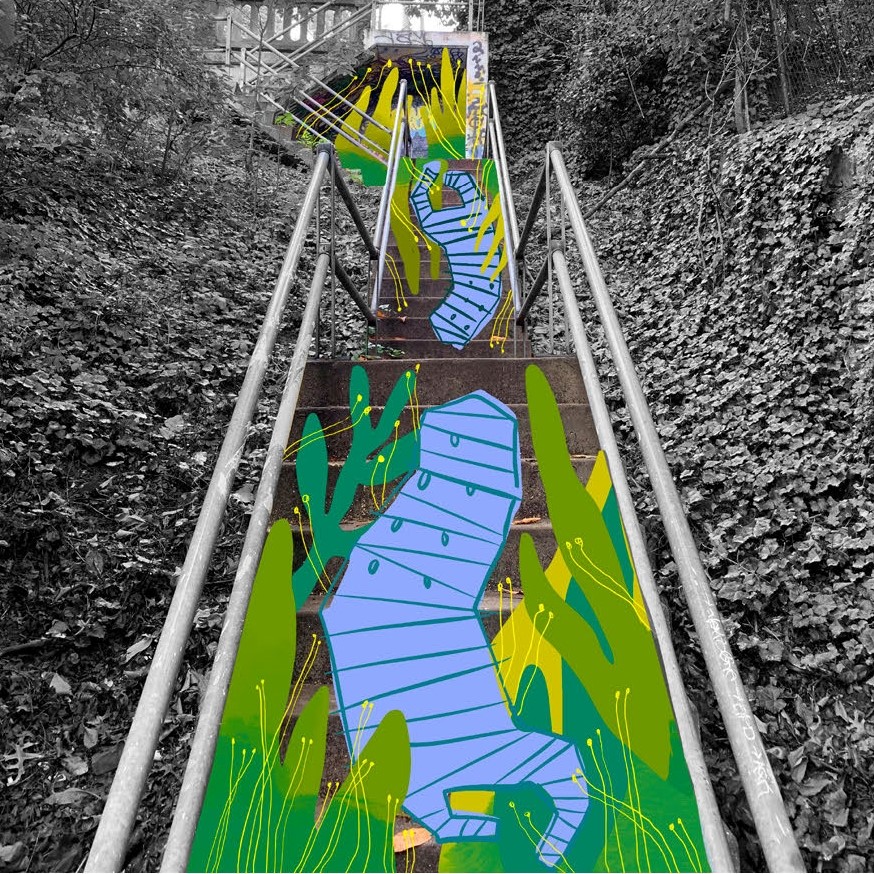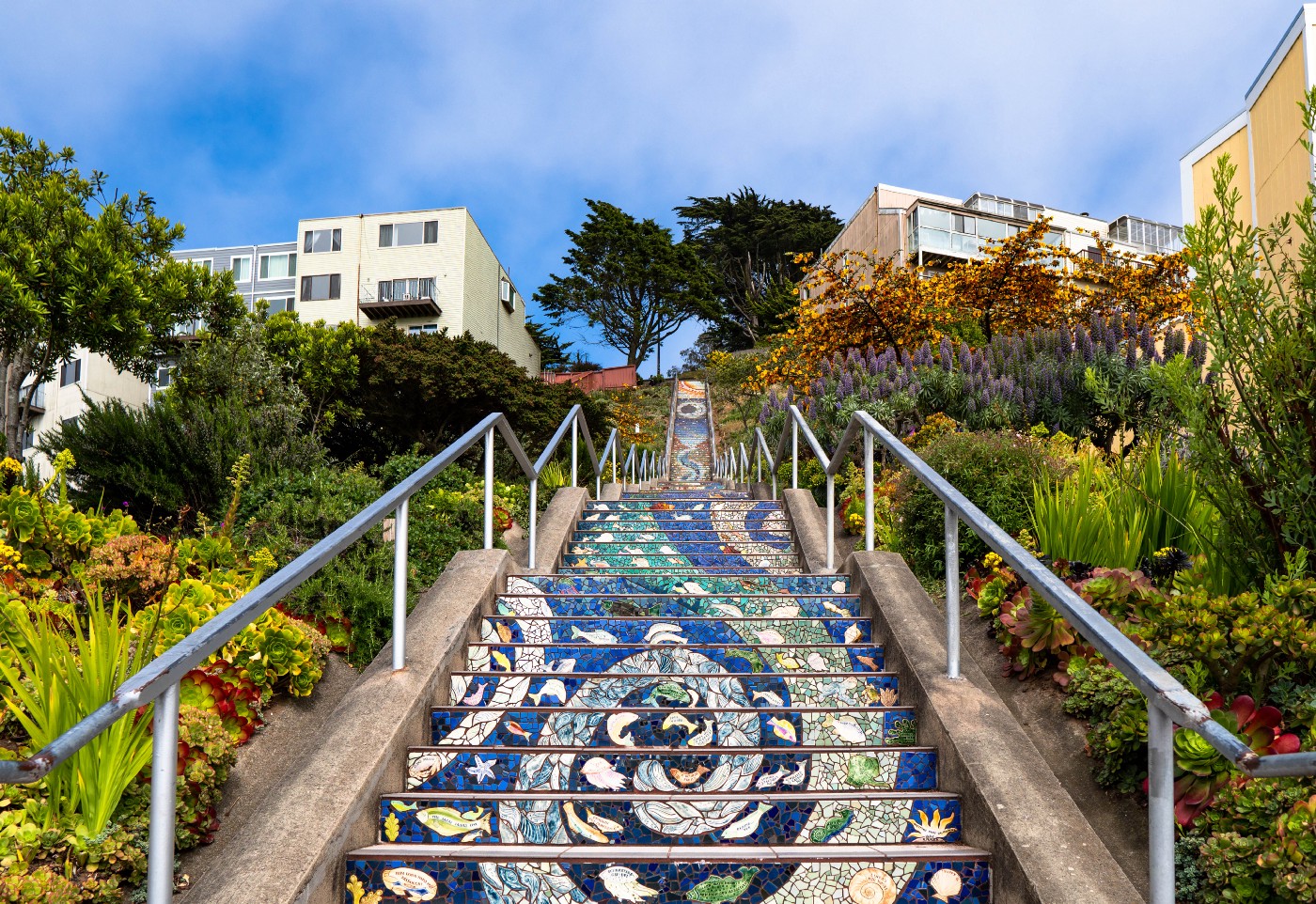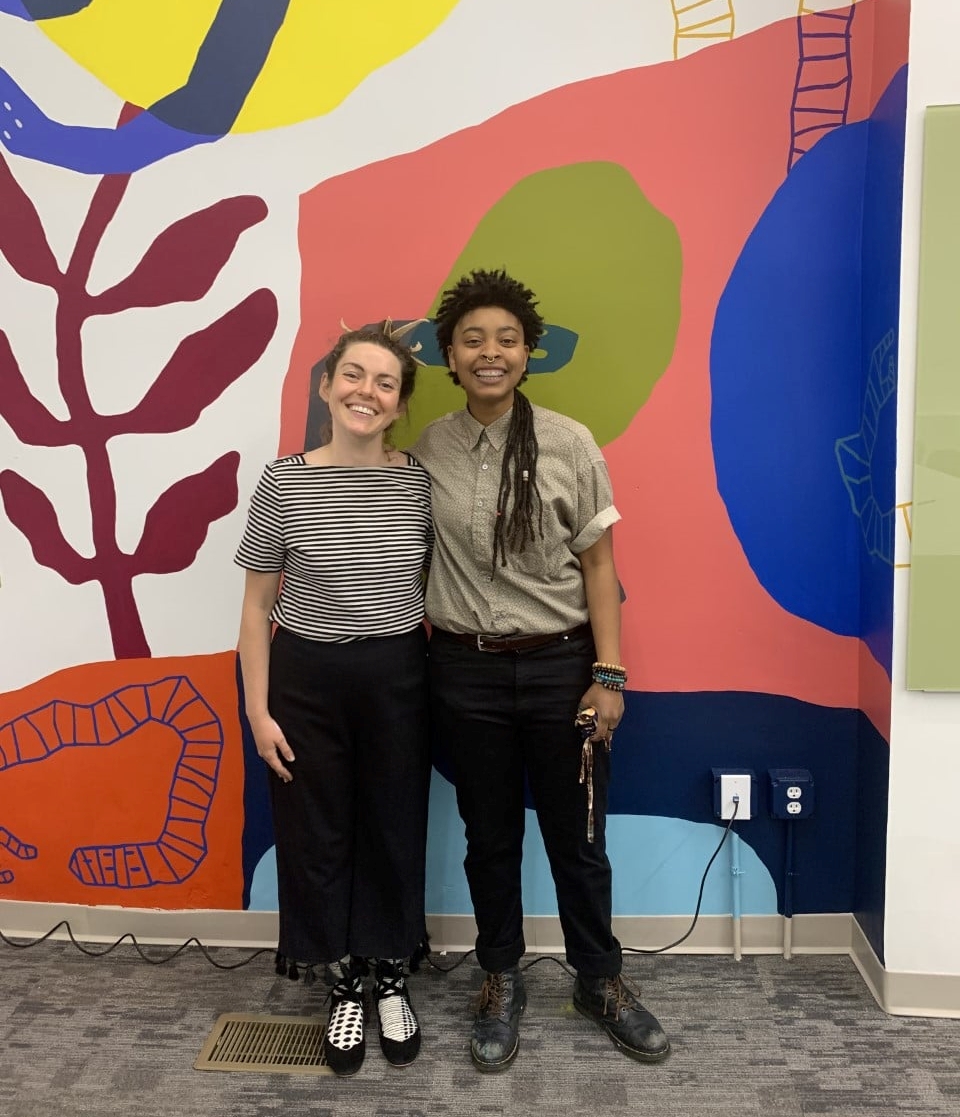Public Art:
How can art transform a public stairway to increase its attractiveness and usage?
The Artists and their Work:
![]()
About the Artists ︎︎︎
Lizzy Duquette (left) is a DAAP graduate with a concentration in drawing and printmaking who has worked with ArtWorks Cincinnati, Price Hill Creative Community Festival, Cincinnati Museum Center, and Visionaries + Voices, and designs and fabricates theater scenery for Queen City Opera.
Dai Williams (right) is an illustrator, printer, muralist and teaching artist from and living in Cincinnati. They use their experience from attending the Art Academy of Cincinnati, collaboration with Artworks and work in the printing and design industry, to create art that connects with the world through their alter ego S0FT GH0ST. Expressed through color theory, minimal line, patterns, abstraction and storytelling, the SOFT GHOST UNIVERSE has transformed from a reflection of their experiences seeking safe spaces and inclusiveness to now creating those spaces for themselves and others. Bringing new possibilities for youth to learn about world-building, community-finding and self-discovery.
Ghost Garden
︎︎︎
Ghost Garden is our first stairway mural project, installed on the Upper Ohio Avenue Steps, and represents a blending between the artistic styles of Dai Williams and Lizzie Duquette. The process began by priming the steps, then the artists traced the outlines of their ideas in chalk. These figures were filled in with paint, and then graduated and adapted to create effects of overlapping, transparency, and interweaving





Inspiration and Precedents
Pittsburgh, PA ︎︎︎
The city of Pittsburgh has the more public stairways than any other city in the United States and uses a specific methodology to rate the usefulness of public stairs to their community on a scale of 1-10 based on nearby schools, transit stops, distance to amenities, and neighborhood car ownership, and prioritize maintenance accordingly. In 2015, the South Side Slopes neighborhood coordinated with Laura Jean McLaughlin to create a mosaic on a neighborhood stairway, and as part of the 2016-2019 homecoming project, Njaimeh Njie created a mural on the steps of the Kaufman Auditorium. In 2019, a series called The Steps We Take featured a temporary event series on public stairs in four neighborhoods to celebrate their central role in these communities.
 Njaimeh Njie via https://opapgh.org/
Njaimeh Njie via https://opapgh.org/

Photo by Marie Freeman via https://www.appstate.edu/appalachians-future/building-physical-infrastructure/arts-corridor/
Boone, NC ︎︎︎
The concept of the Campus Arts Corridor at Appalachian State University arose as a means to connect two of the main university arts centers, the Schaefer Center for the Performing Arts and the Turchin Center for the Visual Arts, which are located on opposite sides of campus. In 2020, a vibrant mural, Transit Candy (named in a community-wide contest) was designed and painted on the grand staircase outside the main entrance of the Turchin Center by Baltimore based artists Jessie Unterhalter and Katey Truhn. The mural has provided a boost of joy to pedestrians traversing this link between campus and King Street, which is the main thoroughfare of downtown Boone. It has also served to brand the brick visual arts building to reflect the abundant creativity housed inside. The staircase has become a popular spot for personal and group photos, local advertisements, and social media.
San Francisco, CA ︎︎︎
The 16th Street Steps grew out of a neighborhood initiative in Golden Gate Heights to beautify a well-traveled pedestrian path in their neighborhood. A tile mosaic with a theme of “Sea to Stars” was installed in 2005 by Aileen Barr and Collete Crutcher and the areas around the stairs were landscaped with succulents donated by the San Francisco Cactus and Succulent society. The project involved sponsorship from San Francisco Beautiful, Union Bank, and the neighborhood held three ceramic workshops so that community residents could volunteer to help create the mosaic panels for the stairs. Today the stairs have inspired other mosaic projects across the city, such as the Lincoln Park steps and Hidden Garden Steps.
 Photo by Jack Chen via https://thebolditalic.com/7-beautiful-mosaic-tiled-stairways-in-san-francisco-cf370cdbb627
Photo by Jack Chen via https://thebolditalic.com/7-beautiful-mosaic-tiled-stairways-in-san-francisco-cf370cdbb627
 Photo by The man with the golden cam via https://www.flickr.com/photos/atopeconlatxabaleria/2425025787/sizes/z/in/photostream/
Photo by The man with the golden cam via https://www.flickr.com/photos/atopeconlatxabaleria/2425025787/sizes/z/in/photostream/Caltagirone, Italy ︎︎︎
In 1956, the City of Caltagirone in Sicily installed majolica tiles on all 142 steps of the central stairway of their town, which tell a chronological story through the historical art styles of Sicily that redecorate the tiles. The stairs are lined by restaurants and shops, and leads to the Church of Santa Maria which sits at the top of the hill. The stairway is decorated with patterns of flowers in May for the festival of the Infiorata, and with lanterns in July for an event called “The Illuminated Staircase.”
Beirut, Lebanon ︎︎︎
A team of artists that call themselves Dizhayners painted the Massad Stairs in the Mar Mikhael neighborhood of Beirut in 2012. The stairway connects two neighborhoods, is a popular spot for drinking coffee and socializing, and is a route of easy access to many buildings, including the St. George’s Hospital. In 2013, rumors arose that the government planned to demolish these stairs leading to protesting and sit-ins on the staircase, although the government denied these allegations. Over the course of a decade, many noticed that the stairs were not well maintained or cleaned, leading to a call for a joint project between GAIA-heritage, RAB Architects, and others to renovate the stairs.
 Photo by Amani el Charif via https://www.lebanontraveler.com/en/magazine/beirut-colorful-stairs/
Photo by Amani el Charif via https://www.lebanontraveler.com/en/magazine/beirut-colorful-stairs/
